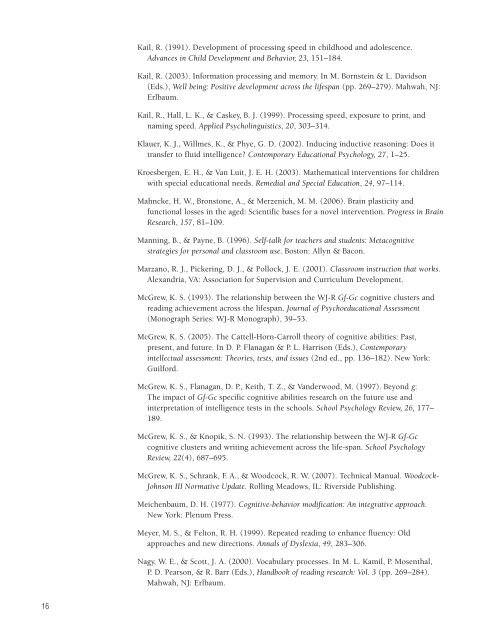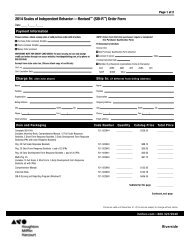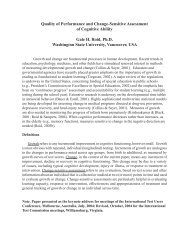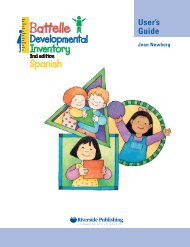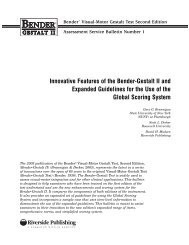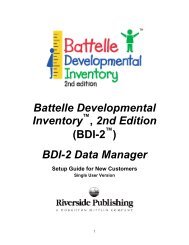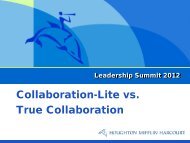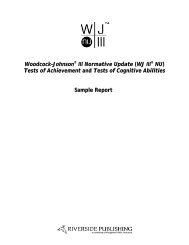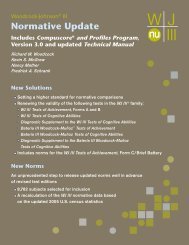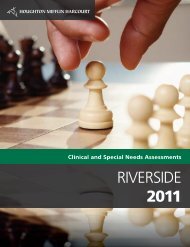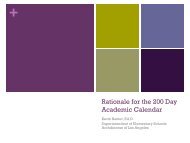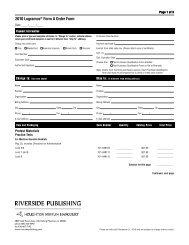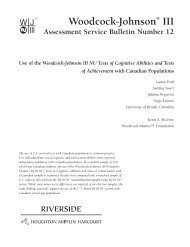Woodcock- Johnson III Tests of Cognitive Abilities - Riverside ...
Woodcock- Johnson III Tests of Cognitive Abilities - Riverside ...
Woodcock- Johnson III Tests of Cognitive Abilities - Riverside ...
You also want an ePaper? Increase the reach of your titles
YUMPU automatically turns print PDFs into web optimized ePapers that Google loves.
Kail, R. (1991). Development <strong>of</strong> processing speed in childhood and adolescence.Advances in Child Development and Behavior, 23, 151–184.Kail, R. (2003). Information processing and memory. In M. Bornstein & L. Davidson(Eds.), Well being: Positive development across the lifespan (pp. 269–279). Mahwah, NJ:Erlbaum.Kail, R., Hall, L. K., & Caskey, B. J. (1999). Processing speed, exposure to print, andnaming speed. Applied Psycholinguistics, 20, 303–314.Klauer, K. J., Willmes, K., & Phye, G. D. (2002). Inducing inductive reasoning: Does ittransfer to fluid intelligence? Contemporary Educational Psychology, 27, 1–25.Kroesbergen, E. H., & Van Luit, J. E. H. (2003). Mathematical interventions for childrenwith special educational needs. Remedial and Special Education, 24, 97–114.Mahncke, H. W., Bronstone, A., & Merzenich, M. M. (2006). Brain plasticity andfunctional losses in the aged: Scientific bases for a novel intervention. Progress in BrainResearch, 157, 81–109.Manning, B., & Payne, B. (1996). Self-talk for teachers and students: Metacognitivestrategies for personal and classroom use. Boston: Allyn & Bacon.Marzano, R. J., Pickering, D. J., & Pollock, J. E. (2001). Classroom instruction that works.Alexandria, VA: Association for Supervision and Curriculum Development.McGrew, K. S. (1993). The relationship between the WJ-R Gf-Gc cognitive clusters andreading achievement across the lifespan. Journal <strong>of</strong> Psychoeducational Assessment(Monograph Series: WJ-R Monograph), 39–53.McGrew, K. S. (2005). The Cattell-Horn-Carroll theory <strong>of</strong> cognitive abilities: Past,present, and future. In D. P. Flanagan & P. L. Harrison (Eds.), Contemporaryintellectual assessment: Theories, tests, and issues (2nd ed., pp. 136–182). New York:Guilford.McGrew, K. S., Flanagan, D. P., Keith, T. Z., & Vanderwood, M. (1997). Beyond g:The impact <strong>of</strong> Gf-Gc specific cognitive abilities research on the future use andinterpretation <strong>of</strong> intelligence tests in the schools. School Psychology Review, 26, 177–189.McGrew, K. S., & Knopik, S. N. (1993). The relationship between the WJ-R Gf-Gccognitive clusters and writing achievement across the life-span. School PsychologyReview, 22(4), 687–695.McGrew, K. S., Schrank, F. A., & <strong>Woodcock</strong>, R. W. (2007). Technical Manual. <strong>Woodcock</strong>-<strong>Johnson</strong> <strong>III</strong> Normative Update. Rolling Meadows, IL: <strong>Riverside</strong> Publishing.Meichenbaum, D. H. (1977). <strong>Cognitive</strong>-behavior modification: An integrative approach.New York: Plenum Press.Meyer, M. S., & Felton, R. H. (1999). Repeated reading to enhance fluency: Oldapproaches and new directions. Annals <strong>of</strong> Dyslexia, 49, 283–306.Nagy, W. E., & Scott, J. A. (2000). Vocabulary processes. In M. L. Kamil, P. Mosenthal,P. D. Pearson, & R. Barr (Eds.), Handbook <strong>of</strong> reading research: Vol. 3 (pp. 269–284).Mahwah, NJ: Erlbaum.16


